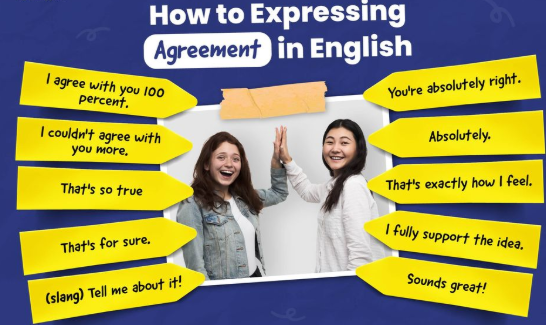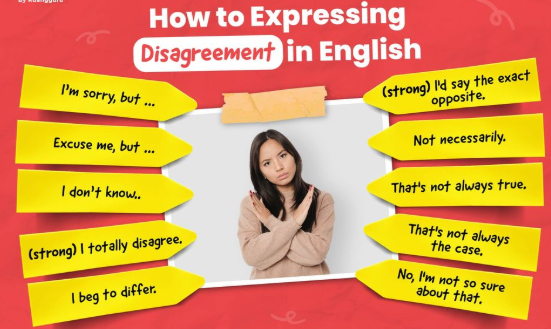Definition, Function & Examples of Agreement & Disagreement Dialogue
What is meant by agreement and disagreement ?
As we have discussed briefly above, in English, agreement and disagreement are expressions to express agreement or disagreement with someone’s opinion.
What is agreement ? So, agreement is an expression or attitude of agreement (verbal or nonverbal) towards the actions and opinions of others.
On the other hand, disagreement is an attitude of opposition to the actions or opinions given by other people to an individual or group.
So, we can say we disagree when we consider the actions or opinions of the other person to be incorrect, inappropriate, baseless, or unpleasant, guys.
When Are Agreement and Disagreement Used?
We’re usually not aware of this when we express ourselves. After all, agreement and disagreement often arise in conversations between individuals, individuals, and groups.
Of course, agreement is used when you’re in the same “position” as the person you’re talking to. Meanwhile, disagreement is used when you feel that what the person is saying makes you uncomfortable.
If you are someone who is “uncomfortable”, maybe it’s time to learn how to express disagreements so that you don’t just say “yes”, gang .
What is the Function of Agreement and the Function of Disagreement ?
Apart from its main function, which is to express agreement or disagreement with something, there are actually other functions, you know .
Agreements and disagreements can also help us hone our ability to ask and give opinions . Moreover, disagreements are usually followed by additional opinions or reasonable arguments.
Well , this will certainly make someone more confident in expressing their opinions and reaching a more solid decision.
What are the expressions of agreement ?
There are also levels of agreement. If you’ve ever filled out a research questionnaire, researchers typically give you the option to “agree” or “strongly agree” with a statement.
Well, the reason is because, usually there are people who only agree because they follow the majority opinion or because of limited knowledge, then there are also those who strongly agree, meaning their position cannot be challenged because they have stronger knowledge about something.

1. Example of the expression “Just Agree “
You can use this expression when you agree, but don’t completely agree, but circumstances dictate that you still agree. For a simple way , you can use the various expressions below:
- Yes. (Ya)
- Right. (Right)
- Cool. (Turn)
- Great .
- No problem .
- I agree . (I agree)
- I know. (I know)
- Fine with me . (No problem)
- That’s right . (That’s right)
- You ‘re right.
- I feel the same . (I feel the same)
- Agreed .
- I’m with you . (I agree with you.)
- I am of the same opinion.
- It certainly is . (It certainly is)
2. Examples of Expressions of Strongly Agree
Yuhu , if some of the phrases below are valid to express very strong agreement and there is nothing that is blocking the slightest when wanting to accept other people’s ideas.
- I agree with you 100 percent (I agree with you 100 percent.)
- I couldn’t agree with you more . (I couldn’t agree with you more.)
- That’s so true. (That’s so true.)
- That’s for sure . (That’s for sure.)
- (slang) Tell me about it! ((gaul) Nah, kan!)
- You’re absolutely right . (You’re absolutely right.)
- Absolutely. (Exactly.)
- That’s exactly how I feel .
- I fully support the idea.
- Sounds great !
- I certainly agree with you . (I certainly agree with you.)
- I agree with that . (I agree with that.)
- I fully support the idea.
- Great idea !
- Exactly! (Tepat)
How to Express Disagreement in English?
So, how do you express disagreement? Well , there are two ways, guys : formal and informal. Here are some expressions of disagreement you can use:

1. Formal Situation
Examples of formal situations include meetings with business associates, collaborations with work partners , discussions with teachers and lecturers, etc. Here are some examples of expressions:
- I can’t be along with you. (I don’t understand you.)
- I wouldn’t say that. (I couldn’t say that.)
- I can’t agree with. (I can’t agree with your opinion.)
- I’m not sure about that. (I’m not sure about that.)
- I wouldn’t say that. (I don’t know.)
2. Informal Situation
This expression is more appropriate for you to use with friends, peers, or people younger than you in informal situations. Examples of appropriate expressions of disagreement are:
- Speak for yourself… (That’s what you think.)
- Not necessarily .
- Are you kidding me? (Are you kidding me?)
- You must be joking … (You must be joking.)
- That ‘s ridiculous. I couldn’t agree less.
3. Totally Disagree (Totally Disagree)
You can also express your disagreement bluntly, aka “strongly disagree,” as in expressing agreement, which we discussed earlier. Some expressions you can use are:
- Absolutely not.. (Absolutely not..)
- Of course not… (Of course not..)
- Nothing of the kind! (Nothing like that!)
- I disagree completely. (I totally disagree.)
- That’s absolutely not true. (That’s absolutely not true.)
- That ‘s totally unacceptable .
- I think you’re totally mistaken. (I think you’re totally wrong.)
Partly Agree/Not Sure
You’ve probably been in a situation where you agree with someone’s idea or opinion, but don’t completely agree. Or perhaps there’s something that needs to be cleared up and discussed first to reach a mutual agreement.
Well , this is usually also called partly agreeing. Here’s an expression you can use when you’re reluctant to offer additional ideas:
- I suppose (so )
- I guess (so )
- I think (so)
- Perhaps you’re right
- Well, maybe you’re right (Well, maybe you’re right)
How to Provide Additional Opinions in a Partly Disagreement
If you are still half-hearted in agreeing with someone else’s opinion, and then want to provide additional ideas, then you can use common expressions like the ones below:
- I agree with you up to a point, but… (I agree with you up to a point, but…)
- That’s quite true, but… (That’s quite true, but…)
- I agree with you in principle, but… (In principle I agree, but…)
- It’s certainly true that…, but on the other hand…. (It’s certainly true that…, but on the other hand….)
- I can see that…., but I think it’s also important to consider…. ( I can see that…., but I think it’s also important to consider….)
- That makes sense, but could it also be true that…. (That makes sense, but could it also be true that….)
- I’d agree with you if…., but not if… (I agree with you if…., but not if…)
- I see what you mean with…, but I also think we need to consider…. (I see what you mean by…, but I also think we need to consider….)
- That’s a good point, but in my opinion….
- That could apply in some situations, but what about when….?
Example of Agreement and Disagreement Conversations
Here’s a list of examples of agreement and disagreement dialogues you can practice with friends, complete with their meanings . Pay close attention!
Dialog 1
Practice Dialogue: Family vacation to Turkey.
Jack: Grace, next week Jems and Emma are already on summer break, right?
Grace : Yes Jack, they will get a full month off.
Jack : How about we take them on vacation to Turkey?
Grace : I totally agree with you. Where is the destination about to go?
Jack: How about going to Cappadoccia?
Grace: Tell me about it!
Grace: Absolutely agree!
Jack: There, there are a lot of hot air balloons. It’s a famous destination, Jems and Emma can enjoy a
hot air balloon ride.
Grace : I can see that was fun, but I think it ‘s also important to consider if Emma is afraid of heights .
Jack: Oh yeah, I forgot about that.
Grace : We ‘ll ask her later, maybe she has a little bit of courage.
Jack : I fully support the idea. Since Emma has also grown older now, she should have been braver.
Grace: Well, maybe you’re right.
Jack : Will a 10-day trip be enough?
Grace : Yes , I certainly agree with you. Within ten days, we can visit more than 10 destinations, Jack .
Jack : All right , I’m going to tell Jems and Emma this plan at our dinner, I’m going to take 14 days leave from my office.
Grace: Wow, sounds great. Thank you Jack.